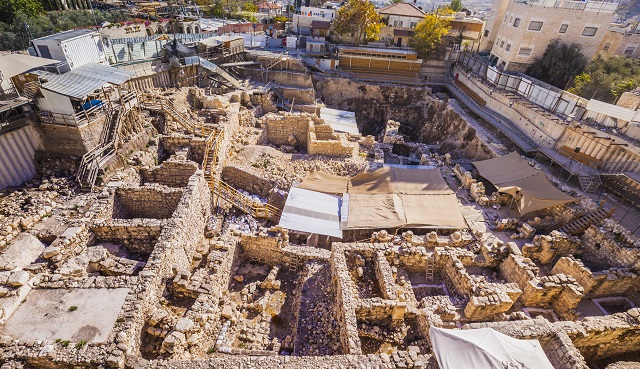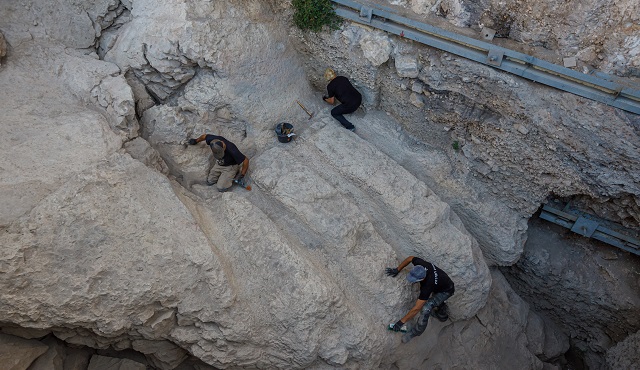An ancient channel installation was recently discovered in Jerusalem’s City of David National Park that dates back to the time of Kings Joash and Amaziah. But no one knows what it was used for so it became known as the Jerusalem Mystery. Even investigators from the police forensic unit joined the archeological quest to solve the mystery, but there are still no answers.
The excavation’s findings will be open for public viewing during the 24th City of David Studies of Ancient Jerusalem conference to be held next week.
The ancient channel installation was the first of its kind ever discovered in Israel and was in use around 2,800 years ago – during the First Temple period. According to researchers from the Israel Antiquities Authority and Tel Aviv University, “The channels were likely used to soak some type of product. Their central location indicates that the product was connected to the Palace or Temple economy.”
Will you offer us a hand? Every gift, regardless of size, fuels our future.
Your critical contribution enables us to maintain our independence from shareholders or wealthy owners, allowing us to keep up reporting without bias. It means we can continue to make Jewish Business News available to everyone.
You can support us for as little as $1 via PayPal at office@jewishbusinessnews.com.
Thank you.
What archeologists described as “unique and large-scale production installations” carved out of the rock and dating to the 9th Century BCE were unearthed in excavations conducted by the Israel Antiquities Authority and Tel Aviv University in the City of David National Park, funded by the Elad Foundation.
“What was this obscure product that was important to the economy of the city, Temple, or Palace during the times of the ancient Judean Kings,” ask the experts. The purpose of the installation is still unclear, but their uniqueness and location near the Temple and the Palace, speculate the experts, suggests that their products were integrated into the economy of these prominent institutions.
Well, Israel is certainly the place for such great archeological discoveries. Earlier this month, an ancient 5,500-year-old gate was uncovered in an Israel Antiquities Authority Excavation carried out at Tell Erani near Kiryat Gat. The city gate was part of the fortifications of one of the most important tell sites for understanding the beginning of urbanization.
Also in August a young youth group leader discovered an ancient 1,500-year-old “magical mirror” in an archaeological excavation in northern Israel.
The excavation thus far has uncovered two installations about 10 meters apart, which may have composed one large installation. Such structures have not been found anywhere else in Israel, hence their uniqueness. The excavators found the first installation at the northeastern end of the Givati Parking Lot excavation, which includes a series of at least nine channels that were smoothed. On top of the rock cliff that encloses the installation to the south can be found seven drain pipes, which carried liquid from the top of the cliff, which served as an activity area, to the channel installation.

Excavations of the Givati Parking Lot dig in the City of David. (Photo:_ Kobi Harathi, City of David)
Dr. Yiftah Shalev, a senior researcher at the Israel Antiquities Authority, said: “We looked at the installation and realized that we had stumbled on something unique, but since we had never seen a structure like this in Israel, we didn’t know how to interpret it. Even its date was unclear. We brought a number of experts to the site to see if there were any residues in the soil or rock that are not visible with the naked eye, and to help us understand what flowed or stood in the channels. We wanted to check whether there were any organic remains or traces of blood, so we even recruited the help of the police forensic unit and its research colleagues around the world, but so far – to no avail.”
Prof. Yuval Gadot of Tel Aviv University’s Archeology and Ancient Near Eastern Civilizations Department explained that, while there are some differences in the way the two channels were hewn and designed, it is evident that the second installation is very similar to the first.
Archeologists say they have, at least, managed to date when the facility fell out of use – at the end of the 9th Century BCE, during the days of the biblical kings of Judah – Joash and Amaziah. They assume that the two installations, which may have been used in unison, were constructed several decades earlier.
In that era, Jerusalem was comprised only of the City of David and the Temple Mount, which served as the heart of the city. The central location of the channels near the city’s most prominent areas indicates, explained the archeologists, that the product made using them was connected to the economy of the Temple or Palace.
“Since the channels don’t lead to a large drainage basin and the direction of their flow varies, it is possible that the channels, at least in the northern installation, were used to soak products – and not to drain liquids,” added Dr. Shalev. “The production of linen, for example, requires soaking the flax for a long time to soften it. Another possibility is that the channels held dates that were left out to be heated by the sun to produce silan (date honey), like similarly shaped installations discovered in distant places such as Oman, Bahrain and Iran.”




